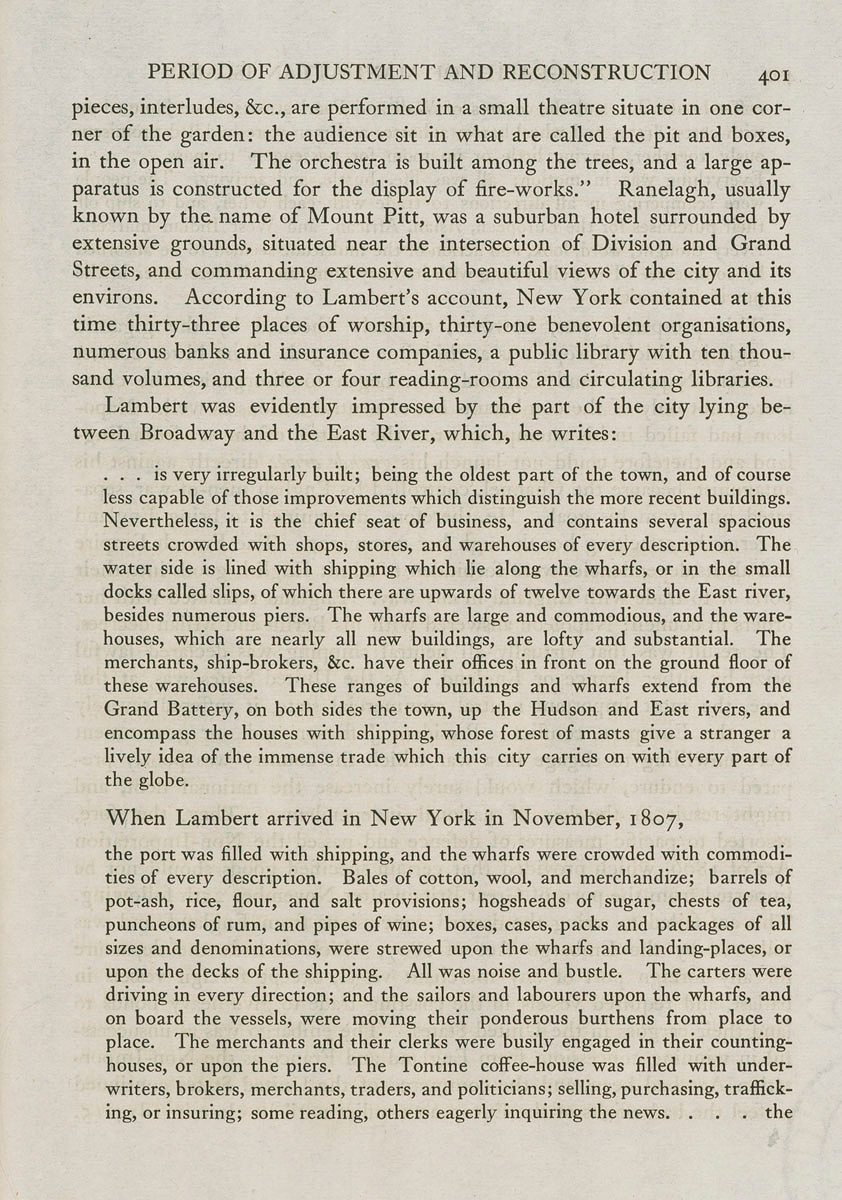PERIOD OF ADJUSTMENT AND RECONSTRUCTION 401
pieces, interludes, &c., are performed in a small theatre situate in one cor¬
ner of the garden: the audience sit in what are called the pit and boxes,
in the open air. The orchestra is built among the trees, and a large ap¬
paratus is constructed for the display of fire-works." Ranelagh, usually
known by thcL name of Mount Pitt, was a suburban hotel surrounded by
extensive grounds, situated near the intersection of Division and Grand
Streets, and commanding extensive and beautiful views of the city and its
environs. According to Lambert's account. New York contained at this
time thirty-three places of worship, thirty-one benevolent organisations,
numerous banks and insurance companies, a public library with ten thou¬
sand volumes, and three or four reading-rooms and circulating libraries.
Lambert was evidently impressed by the part of the city lying be¬
tween Broadway and the East River, which, he writes:
... is very irregularly built; being the oldest part of the town, and of course
less capable of those improvements which distinguish the more recent buildings.
Nevertheless, it is the chief seat of business, and contains several spacious
streets crowded with shops, stores, and warehouses of every description. The
water side is lined with shipping which He along the wharfs, or in the small
docks called slips, of which there are upwards of twelve towards the East river,
besides numerous piers. The wharfs are large and commodious, and the ware¬
houses, which are nearly all new buildings, are lofty and substantial. The
merchants, ship-brokers, &c. have their offices in front on the ground floor of
these warehouses. These ranges of buildings and wharfs extend from the
Grand Battery, on both sides the town, up the Hudson and East rivers, and
encompass the houses with shipping, whose forest of masts give a stranger a
lively idea of the immense trade which this city carries on with every part of
the globe.
When Lambert arrived in New York in November, 1807,
the port was filled with shipping, and the wharfs were crowded with commodi¬
ties of every description. Bales of cotton, wool, and merchandize; barrels of
pot-ash, rice, flour, and salt provisions; hogsheads of sugar, chests of tea,
puncheons of rum, and pipes of wine; boxes, cases, packs and packages of all
sizes and denominations, were strewed upon the wharfs and landing-places, or
upon the decks of the shipping. All was noise and bustle. The carters were
driving in every direction; and the sailors and labourers upon the wharfs, and
on board the vessels, were moving their ponderous burthens from place to
place. The merchants and their clerks were busily engaged in their counting-
houses, or upon the piers. The Tontine coffee-house was filled with under¬
writers, brokers, merchants, traders, and politicians; selling, purchasing, traffick¬
ing, or insuring; some reading, others eagerly inquiring the news. . . . the
|








